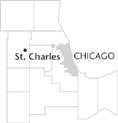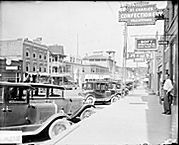| Entries |
| S |
|
St. Charles, IL
|
 DuPage and Kane Counties, 35 miles W of the Loop. The site of St. Charles was well known to the
Potawatomi,
who established two summer camps near the shallows where they forded the
Fox River
and fished. Later settlers also were attracted by the varied nature of the country, with prairie to the west and extensive woods on both sides of the river to the north. They also prized the creeks that ran into the Fox River for mills and used rock outcrops in the area for building stone.
DuPage and Kane Counties, 35 miles W of the Loop. The site of St. Charles was well known to the
Potawatomi,
who established two summer camps near the shallows where they forded the
Fox River
and fished. Later settlers also were attracted by the varied nature of the country, with prairie to the west and extensive woods on both sides of the river to the north. They also prized the creeks that ran into the Fox River for mills and used rock outcrops in the area for building stone.
By 1836 a bridge and dam had been built, and a little town was growing up around them on both the east and west banks. It was at first called Charleston, but as there was already a town in Illinois with that name, it was changed to St. Charles. Most of the early settlers came from New England, and the Yankee influence remained strong throughout the nineteenth century.
From 1849 to about 1859 St. Charles was served by the St. Charles Branch Railroad. But regular rail service did not come until 1871 when the Chicago, Saint Paul & Kansas City Railroad established a depot, ushering in a period of economic growth. Some new industries, like the cheese factory and the milk condensery, processed local farm produce; but others, like the iron works, paper mill, piano factory, and cut-glass factory, took advantage of St. Charles's water power and strategic location. Factory work drew many hundreds of Swedish immigrants, along with substantial numbers of Lithuanians, Belgians, and Danes.

|
There have also been major economic changes, as factories have given way to a variety of service-based enterprises. Still, St. Charles retains evidence of its past, not only in the many early buildings at the center of town, but also in names like Ferson's Creek, named for a Yankee settler, and Brewster and Norton Creeks, called after the mills that once lined their banks.
| St. Charles, IL (inc. 1839) | |||||
| Year |
Total
(and by category) |
Foreign Born | Native with foreign parentage | Males per 100 females | |
| 1900 | 2,675 | 28.2% | 35.6% | 105 | |
| 2,640 | White (98.7%) | ||||
| 35 | Negro (1.3%) | ||||
| 1930 | 5,377 | 25.6% | 36.8% | 106 | |
| 5,330 | White (99.1%) | ||||
| 43 | Negro (0.8%) | ||||
| 4 | Other (0.1%) | ||||
| 1960 | 9,269 | 7.9% | 22.9% | 95 | |
| 9,227 | White (99.5%) | ||||
| 28 | Negro (0.3%) | ||||
| 14 | Other races (0.2%) | ||||
| 1990 | 22,501 | 3.2% | — | 96 | |
| 22,081 | White (98.1%) | ||||
| 82 | Black (0.4%) | ||||
| 25 | American Indian (0.1%) | ||||
| 163 | Asian/Pacific Islander (0.7%) | ||||
| 161 | Other race (0.7%) | ||||
| 585 | Hispanic Origin* (2.6%) | ||||
| 2000 | 27,896 | 6.6% | — | 99 | |
| 26,169 | White alone (93.8%) | ||||
| 462 | Black or African American alone (1.7%) | ||||
| 39 | American Indian and Alaska Native alone (0.1%) | ||||
| 499 | Asian alone (1.8%) | ||||
| 1 | Native Hawaiian and Other Pacific Islander alone (0.0%) | ||||
| 463 | Some other race alone (1.7%) | ||||
| 263 | Two or more races (0.9%) | ||||
| 1,535 | Hispanic or Latino* (5.5%) | ||||
The Encyclopedia of Chicago © 2004 The Newberry Library. All Rights Reserved. Portions are copyrighted by other institutions and individuals. Additional information on copyright and permissions.